The ISKCON Deity Worship Journal
http://www.ksyberspace.com/arcana/1/thread.html
The ISKCON Deity Worship Journal http://www.ksyberspace.com/arcana/1/thread.html |
| Although one can purchase "br?hma?a threads" (upav?ta or yajñopavita) very inexpensively in the market in India, it is highly preferable for a br?hma?a to make them himself. Once you learn how to do it, with a little practice it becomes very simple. The main challenge is to make all strings equally long to avoid getting them tangled with each other. To make sure the strings remain equal in length, the upav?ta should be always taut while tying the knots. One may wind the upav?ta around one?s knees while sitting on the floor, or one may use one?s knee and another stable object like a heavy pot (preferable to two knees for getting sufficient length of the finished upav?ta). Although some devotees can be seen winding the string around one knee and a toe of the other leg when making an upav?ta, this is not considered proper. |
"If one wants to advance in spiritual power, one must receive his mantras from one of these bona fide samprad?yas, otherwise he will never successfully advance in spiritual life. " (Bhag.6.8.42.)If the disciple wishes to worship a particular form of the Lord, he must receive the proper mantras from his spiritual master, or from a devotee or scripture authorized by him. By chanting these mantras for japa and arcana, a disciple who is not under the control of ignorance realizes the relationship between the spiritual meaning of the mantra, and the identity of the deity being worshipped.
One must know the meaning of the mantra which he is reciting; without knowing the meaning of a mantra, one cannot reach the goal. (Yajñavalkya-sm?ti).
The cords of the sacred thread are made up of three strands. If the upper cloth (utt?rya) is missing during a ceremony, the third cord of the upav?ta takes its place. The sacred thread must be made by a brahma?a or brahma?? and tied with a brahma-granthi knot. The dangling part of the upav?ta must be tied under the navel, not on the chest (according to Katy?yana). Traditionally, students of the g-Veda wore it between the chest and the navel; students of the Yajur-Veda at navel level, and students of the Sama-Veda at elbow level.
The upav?ta must be changed when contaminated or spoiled. Although there is no reference in the scriptures about winding the upav?ta around the thumb while chanting G?yatr? or during acamana and p?ja, it is common practice in Bengal. It can be done, but it is not compulsory.
One should not be without upav?ta at any moment and must never allow it to come into contact with contaminated objects. It is a great offense to break the upav?ta of another brahmana, for which one must execute praya?citta (great austerities to atone sins). While passing urine or stool, the sacred thread must be placed on the right ear, which is considered to be as good as a t?rtha (always pure) and thus remains suci, although the body is muci. Otherwise it will be considered contaminated. After ?auca (purification/ taking a shower) the upav?ta can be again placed in its usual position (on the left side). If the thread is too short, it can be placed around the neck as a garland (while in the toilet).
The Scriptures give information about the appearance of G?yatr? devi in the form of time, for it is helpful for the meditation to chant G?yatr?-mantra at the proper time. G?yatr?-mantra must be chanted during the first sandhya which starts 24 minutes before sunrise and ends 24 minutes after. It is said that best is to chant when there are still stars in the sky, second best, when although the stars cannot be seen, the sun has not yet risen, and third best, when the sun is already in the sky.
To chant G?yatr?-mantra in one's home has a certain value; to chant in an open area is ten times better. To chant on the bank of or standing in a river up to the knees is a hundred times better, but chanting in the proximity of the Lord is infinitely better.
The best way to chant G?yatr? is mana?ika, in the mind. Yajñavalkya
says one has to meditate on the sound of every syllable, on the meaning
of every word, and of all the mantras, without moving the tongue
or lips, without shaking the head or neck and without showing the teeth.
The hands must be cleaned, and one must have brushed the teeth before taking
the morning shower. The clothes must be dry and spotlessly clean. Tilaka
must be worn on all the twelve parts of the body and the sika must be tied.
G?yatr? should not be chanted on a bed, in a car, or with the back towards
a guru, temple, m?rti, water, fire or a pippal tree. One
should not wear shoes, doze, yawn, spit, look about or speak. If an important
person such as an ?c?rya arrives while chanting G?yatr?, one must
stop to receive him properly, and only resume after asking his permission.
Who is a br?hma?a?Excerpt from a Room Conversation, New Vrindaban, June 25, 1976 |
|
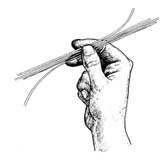 |
|
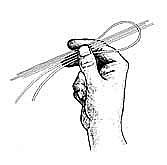 |
|
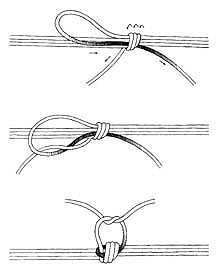 |
|
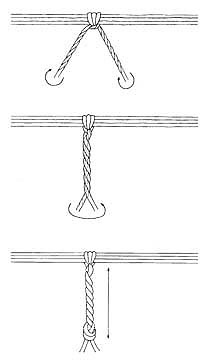
On the meaning of Vai??ava-d?k??It is offered by the ?c?rya. It is the certificate that ?This boy has been trained up as a br?hma?a.? Therefore the sacred thread is a symbolic presentation. Not that to purchase one two paisa worth sacred thread and one becomes br?hma?a. No. Now, of course, in Kali-yuga... Vipratve sutram eva hi. In Kali-yuga this will go on. Vipratve. A br?hma?a, ksatriya, sudra, br?hma?a, ksatriya, vaisya,.. Simply purchase one thread from the market and get it on your body and you become... Vipratve sutram eva hi. No, that is not actually. It is a qualification and it is certificate... Similarly, one who has got the sacred thread means that he has approached qualified ?c?rya, and the ?c?rya has recognized him as br?hma?a. This is sacred thread, not that purchase one sacred thread and get it and become a br?hma?a. No. This is very important thing. First of all educate, and then divide.Excerpt from Bhagavad-g?t? lecture by ®r?la Prabhup?da on April 4, 1974 in Bombay, India. |
How to put on a brahmin thread:
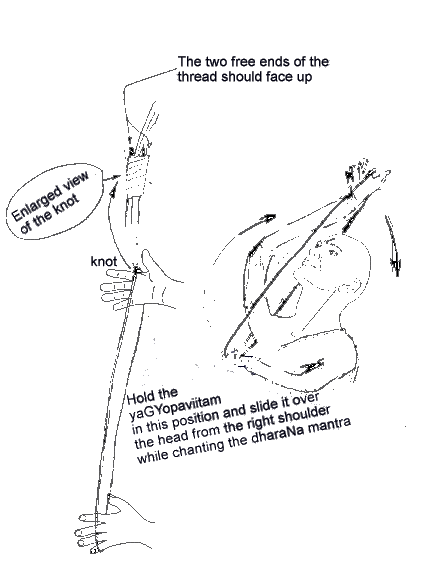
Proceedure for Yajur Veda Upakarma
- Changing the Sacred Thread
When to do?
Ekadasi or if the thread becomes dirty or broken, or yearly on Yajurved Upakarma day.
“After dressing he would sit at his desk and put on tilak and say Gayatri
mantra before taking lunch. Today was a special once in a month opportunity
because Srila Prabhupada would chant on the new thread while holding his
old one. I walked into his sitting room and picked up his discarded thread
only to discover that he had pulled apart each of the threads. He smiled
at me and said, "The Brahmin thread, you have disposed of it?" He said,
"You should bury it underneath the Tulasi plant in the temple courtyard.
Put it in the dirt under the roots."” (Srutikirti dasa. Prabhupad Uvacha
excerpt - October 1972, Vrindavan, India
Camp: Radha Damodara Temple)
How to change the sacred thread:
1. Sit down on an åsana (Face east in the morning and noon, and
north in the evening)
2. Perform åcamana. Simple Åcamana:
om keshavåya nama·h - sip water from bråhma tîrtha
of right hand
om nåråyanåya nama·h - sip water from bråhma
tîrtha of right hand
om mådhavåya nama·h - sip water from bråhma
tîrtha of right hand
(Optional) Special Åcamana:
om govindåya nama·h - sprinkle water on right hand
om vishnave nama·h - sprinkle water on left hand
om madhusüdanåya nama·h - wipe mouth with right hand
om trivikramåya nama·h - wipe mouth with right hand
om våmanåya nama·h - wipe lips with base of thumb
om Shrîdharåya nama·h - wipe lips with base of thumb
om hrishîkeshåya nama·h - sprinkle water on both
hands
om padmanåbhåya nama·h - sprinkle water on feet
om dåmodaråya nama·h - sprinkle water on head
om våsudevåya nama·h - touch lips with right hand
om sankarshanåya nama·h - touch right side of nose with
right hand
om pradyumnåya nama·h - touch left side of nose with right
hand
om aniruddhåya nama·h - touch right eye with right hand
om purushottamåya nama·h - touch left eye with right hand
om adhokshajåya nama·h - touch right ear with right hand
om nrisinghåya nama·h - touch left ear with right hand
om acyutåya nama·h - touch navel with right hand
om janardanåya nama·h - touch heart with right hand
om upendråya nama·h - touch head with right hand
om haraye nama·h - touch right shoulder with right hand
om krishnåya nama·h - touch left shoulder with right hand
(om) tad vishnoh paramagm pada-gugm sadå pasyanti suråyah
divîva
cakshur åtatam tad vipråso vipanyavo
jågrivå-gugm
sah samindhate vishnor yat paramagm padam
3. Sprinkle some water from the pañchapåtra on your new sacred thread. Undo it and stretch it around your knees.
4. Remove the new sacred thread from your knees and hold it horizontally open with the palms of your hands. Turn the thread vertical so that your right hand is up and left hand is down. Your left palm should be turned downwards.
5. Chant the following mantra for putting on the sacred thread.
(om) yajñopavîtam paramagm pavitram
prajåpater
yat sahajagm puraståt
åyushyam agryam pratimuñca
shubhragm
yajñopavîtam
bålam astu tejah
6. Put on the new sacred thread.
7. Wearing both threads chant the Gåyatrî mantra and other mantras given to you by your guru ten times each – on the rekha - lines of middle finger, kanistha – little finger, and tips of other fingers.
8. Chant the following mantra for removing the old sacred thread.
upavîtagm chinnatantugm
jîrnam kanmala düshitam
visrijåmi punar brahman
varco dîrghåyur astu me
9. Remove the old sacred thread from the left shoulder. Bring it down to waist level and break it string by string with both hands. Dispose of it in the same manner as old prasadam, being placed in “a sacred throw out” (to be composted – never to be left laying around, or discarded improperly) (or may be disposed of as